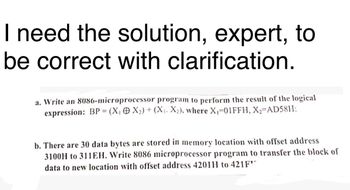
Electric Motor Control
10th Edition
ISBN: 9781133702818
Author: Herman
Publisher: CENGAGE L
expand_more
expand_more
format_list_bulleted
Question

Transcribed Image Text:I need the solution, expert, to
be correct with clarification.
a. Write an 8086-microprocessor program to perform the result of the logical
expression: BP (X₁ X2) + (X₁. X2), where X₁-01FFH, X2=AD58H:
b. There are 30 data bytes are stored in memory location with offset address
3100H to 311EH. Write 8086 microprocessor program to transfer the block of
data to new location with offset address 4201H to 421F
Expert Solution
This question has been solved!
Explore an expertly crafted, step-by-step solution for a thorough understanding of key concepts.
Step by stepSolved in 2 steps

Knowledge Booster
Similar questions
- Solve in 8086 microprocessorarrow_forwardCan you give me a simple example of each mistake in the Emu8086 program? Registers should be of the same size. One way to reduce memory usage is to use AX or AL. Explain.arrow_forwardQ3/(A) False OR True 1- A0-0 and BHE-1 are used as low bank-select signal: 2-AX is 2234 H after executing the following instruction: AAS. If AX-2234H. 3-IP register holds the offset address of the next instruction to be executed. 4- The XLAT instruction in 8086 assembly language is used to perform arithmetic operations between two memory operands. 5- Bus interface unit is responsible formarrow_forward
- I need expert assistance in solving the choices, providing evidence not through explanations but through images or by illustrating with a diagram of the EMU8086 processor. -1. The Intel 8086 microprocessor can read/write 16 bit data from or to a. I/O device b. register (C, memory d. processor 2. Which unit in the 8086 microprocessor is responsible for pre-fetching instructions from memory? a. EU b. ALU c. BIU 3. The memory of 1M byte size could be divided into a. twenty-one b. thirty-four d. CU Kbyte segments. d. sixty-four c. thirty-three 4. Which of the following programming statements is NOT a valid comparison operator in Arduino? != (not equal to) b. < (less than) c. and (logical AND) d. = (equal to) 5. How many A/D converter inputs pins does port-E in the PIC16F877A? b. 6-Pins c. 4-Pins a. 3-Pins 6. How much the size of the program memory space in the b. 16Kx16 bits c. 8Kx14 bits a. 32Kx8 bits 8-Pins PIC16F877A microcontroller? d. 4Kx14 bitsarrow_forward"Using emu8086 programming, I need two different solutions based on a source." write a program to move a block of 100 numbers consecutive bytes of data strings at offset address 8000 H in memory to another block of memory locations starting at offset address A000 H. assume that both blocks are in the same data segment value 3000H . Write an 8086 program that complements the first byte of flags register.arrow_forwardI need a solution very quickly withinarrow_forward
- Q2. (a) Figure 2 shows the pinout diagram (and their functional description) of the 2114 Static RAM memory IC. Using a neat sketch show how such IC may be interfaced with an M68000 microprocessor to realise a system that needs 1K x 16 bits of RAM. [Note: 2114 is a 4-bit memory IC. You will need multiple ICs to make up the 16-bit address bus of M68000 processor.] Ao-Ag Pin Names Address Inputs A6 1 A5 2 A4 AO 5 A16 A2 7 CS 8 GND 9 -23456782 18 Vcc WE Write Enable 17 A7 CS Chip Select 16 A8 1/0₁-1/04 Data Input/Output A3 4 15 A9 VCC Power (+5V) GND Ground 14 I/O 1 13 I/O 2 Truth Table 12 1/03 CS WE Comments 11 I/O 4 H X Chip Deselected L L Write 10 WE L H Read Figure 2 (b) Design an address decoder circuit to realise the following memory map (shown below in hexadecimal notation). The unused address range should generate an active low signal to be connected to the BERR* input of the M68000 microprocessor. Use the partial address decoding technique for your design. ROM1 00 0000 03 FFFF…arrow_forwardQ2. (a) Figure 2 shows the pinout diagram (and their functional description) of the 2114 Static RAM memory IC. Using a neat sketch show how such IC may be interfaced with an M68000 microprocessor to realise a system that needs 1K x 16 bits of RAM. [Note: 2114 is a 4-bit memory IC. You will need multiple ICs to make up the 16-bit address bus of M68000 processor.] Ao-Ag Pin Names Address Inputs A6 1 A5 2 A4 3 A3 4 AO 5 A1 6 A2 7 CS 8 GND 9 +23456700 18 Vcc WE Write Enable 17 A7 CS Chip Select 16 A8 1/01-1/04 Data Input/Output 15 A9 Vcc Power (+5V) GND Ground 14 I/O 1 13 I/O 2 Truth Table 12 1/03 CS WE Comments 11 1/04 Н Chip Deselected L L Write 10 WE L H Read Figure 2 (b) Design an address decoder circuit to realise the following memory map (shown below in hexadecimal notation). The unused address range should generate an active low signal to be connected to the BERR* input of the M68000 microprocessor. Use the partial address decoding technique for your design. ROM1 00 0000 03 FFFF…arrow_forwarda) Design a single-digit decade counter that counts from 0 to 9 and repeats. The single-digit decade counter should be built by a cascaded synchronous binary counter (74LS163) and other basic logic gates. Simulate the complete counter circuit by OrCAD and PSPICE. Capture the circuit schematic and the simulated waveform. (Define the simulation timings for at least one full counting cycle from 0 to 9 and back to 0.) (Hint: Use the DigClock input from the SOURCE as shown below and setup the CLK ONTIME and OFFTIME accordingly for the clock source.) 1/6 Pat DigClock Part List OFFTIME = SuS DSTM1 ONTIME = DELAY= STARTVAL = 0 OPPVAL = 1 Sus EUK FleStim AC Lbrajes Design Cache b) Read the specification of 74LS47 (BCD-to-7-Segment Decoder shown in Appendix) to see how the logic IC operates to drive a 7-segment LED display. Draw the circuit connection of the decade counter in (a) and the decoder to display the count value on the 7-segment LED display. Further explain why common anode…arrow_forward
arrow_back_ios
SEE MORE QUESTIONS
arrow_forward_ios
Recommended textbooks for you
